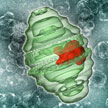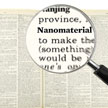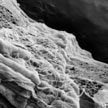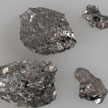Showing Spotlights 113 - 120 of 213 in category All (newest first):
 Vault particles are large, barrel-shaped nanoparticles found in the cytoplasm of all mammalian cells. All human cells so far analyzed have been shown to contain vaults with quantities varying from a few thousand per cell to in excess of 100 000 per cell. As naturally occurring nanoscale capsules, vaults may be useful to engineer as therapeutic delivery vehicles. The particles can be produced in large quantities and are assembled in situ from multiple copies of the single structural protein following expression. Using molecular engineering, recombinant vaults can be functionally modified and targeted, and their contents can be controlled by packaging.
Vault particles are large, barrel-shaped nanoparticles found in the cytoplasm of all mammalian cells. All human cells so far analyzed have been shown to contain vaults with quantities varying from a few thousand per cell to in excess of 100 000 per cell. As naturally occurring nanoscale capsules, vaults may be useful to engineer as therapeutic delivery vehicles. The particles can be produced in large quantities and are assembled in situ from multiple copies of the single structural protein following expression. Using molecular engineering, recombinant vaults can be functionally modified and targeted, and their contents can be controlled by packaging.
Aug 19th, 2013
 For a long time, scientists have been fascinated by the dramatic changes in color used by marine creatures like squids and octopuses, but they never quite understood the mechanism responsible for this. Only recently they found out that a neurotransmitter, acetylcholine, sets in motion a cascade of events that culminate in the addition of phosphate groups to a family of unique proteins called reflectins. Having begun to unravel the natural mechanisms behind these amazing abilities, researchers are trying to use this knowledge to make artificial camouflage coatings. New work addresses the challenge of making something appear and disappear when visualized with standard infrared detection equipment.
For a long time, scientists have been fascinated by the dramatic changes in color used by marine creatures like squids and octopuses, but they never quite understood the mechanism responsible for this. Only recently they found out that a neurotransmitter, acetylcholine, sets in motion a cascade of events that culminate in the addition of phosphate groups to a family of unique proteins called reflectins. Having begun to unravel the natural mechanisms behind these amazing abilities, researchers are trying to use this knowledge to make artificial camouflage coatings. New work addresses the challenge of making something appear and disappear when visualized with standard infrared detection equipment.
Aug 12th, 2013
 Atomically precise manufacturing (APM) can be understood through physics, engineering design principles, proof-of-concept examples, computational modeling, and parallels with familiar technologies. APM is a prospective production technology based on guiding the motion of reactive molecules to build progressively larger components and systems. Bottom-up atomic precision can enable production with unprecedented scope (in terms of product materials, components, systems, and performance), while fundamental mechanical scaling laws can enable unprecedented productivity.
Atomically precise manufacturing (APM) can be understood through physics, engineering design principles, proof-of-concept examples, computational modeling, and parallels with familiar technologies. APM is a prospective production technology based on guiding the motion of reactive molecules to build progressively larger components and systems. Bottom-up atomic precision can enable production with unprecedented scope (in terms of product materials, components, systems, and performance), while fundamental mechanical scaling laws can enable unprecedented productivity.
Jun 11th, 2013
 In order to regulate nanomaterials and to determine mandatory product labelling a generally accepted agreement what the term 'nanomaterial' means has to be reached beforehand. The EU Parliament requires that a definition shallbe science-based and comprehensive. Furthermore, for regulatory measures in individual sectors, it shall be unambiguous, flexible, easy and practical to handle. During the past few years various institutions came up with suggestions for a definition, leading to a recommendation of the EU commission, which finally is being accepted into new and existing EU legislation. Some provisions in this proposal are controversial and the implementation into specific sectoral legislation constitutes a major challenge.
In order to regulate nanomaterials and to determine mandatory product labelling a generally accepted agreement what the term 'nanomaterial' means has to be reached beforehand. The EU Parliament requires that a definition shallbe science-based and comprehensive. Furthermore, for regulatory measures in individual sectors, it shall be unambiguous, flexible, easy and practical to handle. During the past few years various institutions came up with suggestions for a definition, leading to a recommendation of the EU commission, which finally is being accepted into new and existing EU legislation. Some provisions in this proposal are controversial and the implementation into specific sectoral legislation constitutes a major challenge.
Jun 6th, 2013
 The degree of competitiveness in sports has been remarkably impacted by nanotechnology like any other innovative idea in materials science. Within the niche of sport equipments, nanotechnology offers a number of advantages and immense potential to improve sporting equipments making athletes safer, comfortble and more agile than ever. Baseball bats, tennis and badminton racquets, hockey sticks, racing bicycles, golf balls/clubs, skis, fly-fishing rods, archery arrows, etc. are some of the sporting equipments, whose performance and durability are being improved with the help of nanotechnology. Nanomaterials such as carbon nanotubes, silica nanoparticles, nanoclays fullerenes, etc. are being incorporated into various sports equipment to improve the performance of athletes as well as equipments.
The degree of competitiveness in sports has been remarkably impacted by nanotechnology like any other innovative idea in materials science. Within the niche of sport equipments, nanotechnology offers a number of advantages and immense potential to improve sporting equipments making athletes safer, comfortble and more agile than ever. Baseball bats, tennis and badminton racquets, hockey sticks, racing bicycles, golf balls/clubs, skis, fly-fishing rods, archery arrows, etc. are some of the sporting equipments, whose performance and durability are being improved with the help of nanotechnology. Nanomaterials such as carbon nanotubes, silica nanoparticles, nanoclays fullerenes, etc. are being incorporated into various sports equipment to improve the performance of athletes as well as equipments.
May 27th, 2013
 A comprehensive understanding of the brain remains an elusive, distant frontier. To arrive at a general theory of brain function would be an historic event, comparable to inferring quantum theory from huge sets of complex spectra and inferring evolutionary theory from vast biological field work. The proposed Brain Activity Map is a project that will tap the hive mind of experts to make headway in the understanding of the field. Engineers and nanotechnologists will be needed to help build ever smaller devices for measuring the activity of individual neurons and, later, to control how those neurons function. Recent developments in nanoscale analysis tools and in the design and synthesis of nanomaterials have generated optical, electrical, and chemical methods that can readily be adapted for use in neuroscience.
A comprehensive understanding of the brain remains an elusive, distant frontier. To arrive at a general theory of brain function would be an historic event, comparable to inferring quantum theory from huge sets of complex spectra and inferring evolutionary theory from vast biological field work. The proposed Brain Activity Map is a project that will tap the hive mind of experts to make headway in the understanding of the field. Engineers and nanotechnologists will be needed to help build ever smaller devices for measuring the activity of individual neurons and, later, to control how those neurons function. Recent developments in nanoscale analysis tools and in the design and synthesis of nanomaterials have generated optical, electrical, and chemical methods that can readily be adapted for use in neuroscience.
Mar 27th, 2013
 During the past few decades, nanotechnology has had tremendous advances in several areas of research and development. Every week we are witnesses to hundreds of articles and scientific publications reporting new pathways for nanoparticle/nanofiber production, modification and use in modern and high-tech applications. In this respect, the pulp and paper industry has not been absent of this development, which has motivated massive research about nanocellulose. This wonderful material, which is synthesized naturally in wood, is composed of nanofibrils with widths usually less than 20 nm, high aspect ratio and remarkable strength.
During the past few decades, nanotechnology has had tremendous advances in several areas of research and development. Every week we are witnesses to hundreds of articles and scientific publications reporting new pathways for nanoparticle/nanofiber production, modification and use in modern and high-tech applications. In this respect, the pulp and paper industry has not been absent of this development, which has motivated massive research about nanocellulose. This wonderful material, which is synthesized naturally in wood, is composed of nanofibrils with widths usually less than 20 nm, high aspect ratio and remarkable strength.
Mar 20th, 2013
 Strange new materials experimentally identified just a few years ago are now driving research in condensed-matter physics around the world. Tthese "strong 3-D topological insulators" - TIs for short - are seemingly mundane semiconductors with startling properties. Topological insulators offer unique opportunities to control electric currents and magnetism, and are promising materials for future spintronic applications or could provide access to novel, fascinating physical phenomena. While so far, only synthetic TIs had been experimentally identified, researchers in Germany report the discovery of a natural occurring topological insulator: the mineral Kawazulite.
Strange new materials experimentally identified just a few years ago are now driving research in condensed-matter physics around the world. Tthese "strong 3-D topological insulators" - TIs for short - are seemingly mundane semiconductors with startling properties. Topological insulators offer unique opportunities to control electric currents and magnetism, and are promising materials for future spintronic applications or could provide access to novel, fascinating physical phenomena. While so far, only synthetic TIs had been experimentally identified, researchers in Germany report the discovery of a natural occurring topological insulator: the mineral Kawazulite.
Mar 11th, 2013
 Vault particles are large, barrel-shaped nanoparticles found in the cytoplasm of all mammalian cells. All human cells so far analyzed have been shown to contain vaults with quantities varying from a few thousand per cell to in excess of 100 000 per cell. As naturally occurring nanoscale capsules, vaults may be useful to engineer as therapeutic delivery vehicles. The particles can be produced in large quantities and are assembled in situ from multiple copies of the single structural protein following expression. Using molecular engineering, recombinant vaults can be functionally modified and targeted, and their contents can be controlled by packaging.
Vault particles are large, barrel-shaped nanoparticles found in the cytoplasm of all mammalian cells. All human cells so far analyzed have been shown to contain vaults with quantities varying from a few thousand per cell to in excess of 100 000 per cell. As naturally occurring nanoscale capsules, vaults may be useful to engineer as therapeutic delivery vehicles. The particles can be produced in large quantities and are assembled in situ from multiple copies of the single structural protein following expression. Using molecular engineering, recombinant vaults can be functionally modified and targeted, and their contents can be controlled by packaging.
 Subscribe to our Nanotechnology Spotlight feed
Subscribe to our Nanotechnology Spotlight feed





